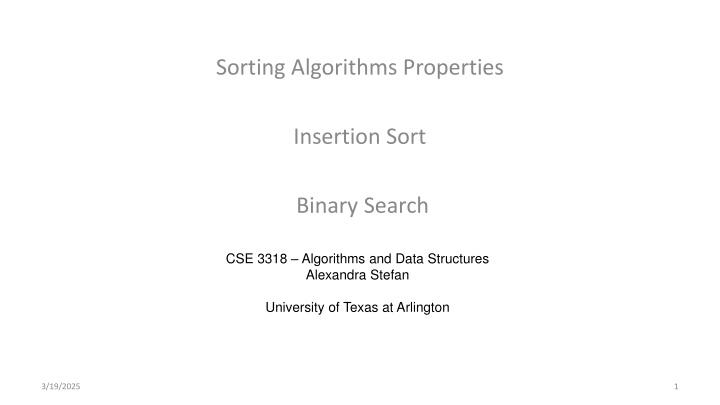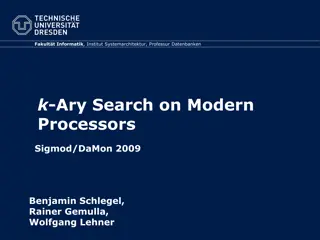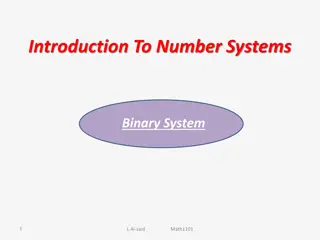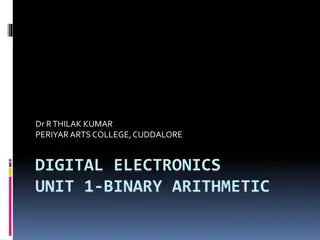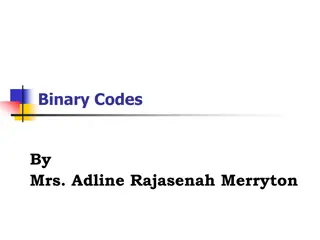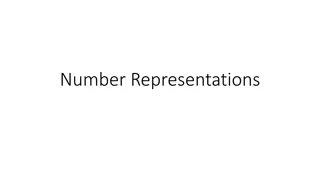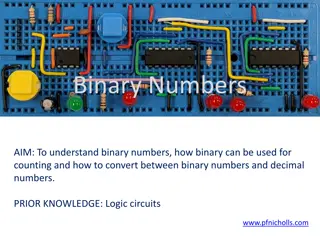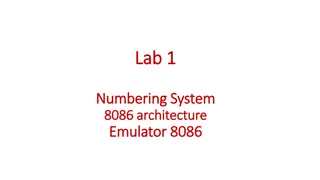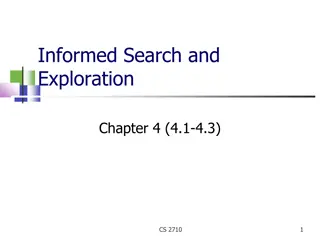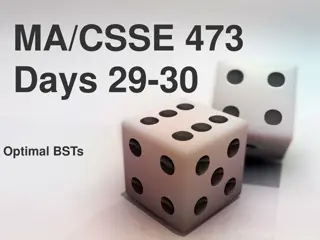Binary Search
Sorting algorithms, insertion sort, binary search, and the properties of stable sorting. Learn about time complexity, space complexity, and the importance of stability in sorting algorithms.
Download Presentation

Please find below an Image/Link to download the presentation.
The content on the website is provided AS IS for your information and personal use only. It may not be sold, licensed, or shared on other websites without obtaining consent from the author.If you encounter any issues during the download, it is possible that the publisher has removed the file from their server.
You are allowed to download the files provided on this website for personal or commercial use, subject to the condition that they are used lawfully. All files are the property of their respective owners.
The content on the website is provided AS IS for your information and personal use only. It may not be sold, licensed, or shared on other websites without obtaining consent from the author.
E N D
Presentation Transcript
Sorting Algorithms Properties Insertion Sort Binary Search CSE 3318 Algorithms and Data Structures Alexandra Stefan University of Texas at Arlington 3/19/2025 1
Summary Properties of sorting algorithms Sorting algorithms Insertion sort Chapter 2 (CLRS) Indirect sorting - (Sedgewick Ch. 6.8 Index and Pointer Sorting ) Binary Search See the notation conventions (e.g. log2N = lg N) Terminology and notation: log2N = lg N Use interchangeably: Runtime and time complexity Record and item 2
Sorting 3
Sorting Sort an array, A, of items (numbers, strings, etc.). Why sort it? To use in binary search. To compute rankings, statistics (min/max, top-10, top-100, median). Check that there are no duplicates intersection and union are easier to perform between 2 sorted sets . We will study several sorting algorithms, Pros/cons, behavior . Insertion sort Optional, self study: selection sort. 4
Properties of sorting Stable: It does not change the relative order of items whose keys are equal. Adaptive: The time complexity will depend on the input E.g. if the input data is almost sorted, it will run significantly faster than if not sorted. see later insertion sort vs selection sort. 5
Other aspects of sorting Time complexity: worst/best/average Number of data moves: copy/swap the DATA RECORDS One data move = 1 copy operation of a complete data record Data moves are NOT updates of variables independent of record size (e.g. loop counter ) Space complexity: Extra Memory used Do NOT count the space needed to hold the INPUT data, only extra space (e.g. copy of data) (1): In place methods: constant extra memory (N): Uses extra space proportional to the number of items: For pointers (e.g. linked lists or indirect access) For a copy of the data Direct vs indirect sorting Direct: move items as needed to sort Indirect: move pointers/handles to items. Can keep the key with pointer or not. Later: non-comparison sorting 6
Stable sorting A sorting algorithm is stable iff, after it sorts an array, any two records that compare equal, will still be in the same relative order as they were before sorting and this happens forevery possible input array. Example: An item consists of an int (e.g. GPA) and a string (e.g. name). Sort based on: GPA (integer) 4 Bob 3 Tom 4 Anna 3 Jane 1 Henry Stable sort (OK: Tom before Jane and Bob before Anna): 1 Henry 3 Tom 3 Jane 4 Bob 4 Anna Unstable sort (violation: Anna is now before Bob): 1 Henry Tom 3 3 Jane 4 Anna 4 Bob Note: Stable is a property of the algorithm, NOT of the algorithm-data pair. You CANNOT say This algorithm is stable for this input . It must be so for all inputs. 7
Stable sorting - Application Applications Sorting by 2 criteria, E.g.: 1st by GPA, 2nd by name: When the GPA is the same, have data in order of names Solution: First sort by name (with any method) Next, with a stable sort, sort by GPA Alternative solution: write a more complex comparison function. Part of other sorting methods See later: LSD radix sort uses a stable sort (count sort). 8
Proving an Algorithm is Stable An algorithm is stable if we can guarantee/prove that this property happens for any input (not just a few example inputs). => To prove it, must use an actual proof (possibly using a loop invariant) or give a very good explanation. Checking that it works on a few examples is NOT a proof. It must work for every possible input that is valid. An algorithm is not stable if there is at least one possible input for which it breaks the property. => To prove it, find one example input for which the property fails. => easier to prove. Intuition: if an algorithm swaps items that are away from each other (jump over other items) it is most likely NOT stable. This statement is a guideline, not a proof. Make sure you always find an example if you suspect this case. 9
Insertion sort Process the array from left to right. Step j (outer loop): - elements A[0],A[1], A[j-1] are already sorted - insert element A[j] in it s place among A[0],..A[j-1] (inner loop) Each row shows the array after one iteration of the outer loop (after step j). original 5 3 7 8 5 0 4 Elements in shaded cells are sorted, but they have only items that were originally in the shaded cells. They are not in final position (e.g. see the 8 move all the way to the right). 1st 3 5 7 8 5 0 4 2nd 3 5 7 8 5 0 4 3rd 3 5 7 8 5 0 4 4th 3 5 5 7 8 0 4 5th 0 3 5 5 7 8 4 6th 0 3 4 5 5 7 8 See TedEd video Wikipedia (see A graphical example of insertion sort ): https://en.wikipedia.org/wiki/Insertion_sort Brief and nice resource: http://interactivepython.org/runestone/static/pythonds/SortSearch/TheInsertionSort.html Animation for version that swaps elements: https://youtu.be/Q1JdRUh1_98 (sent by Aryan) 11
5 3 7 8 5 0 4 Insertion Sort 3 5 7 8 5 0 4 void insertion_sort(int A[],int N){ int j,k,curr; for (j=1; j<N; j++){ curr = A[j]; // insert curr (A[j]) in the // sorted sequence A[0 j-1] k = j-1; while ((k>=0) && (A[k]>curr)){ A[k+1] = A[k]; k = k 1; } A[k+1] = curr; } 3 5 7 8 5 0 4 3 5 7 8 5 0 4 3 5 5 7 8 0 4 0 3 5 5 7 8 4 0 3 4 5 5 7 8 Inner loop time complexity: Best : Worst: Average: 1 j j j/2 1 1 1 1/2 2 1 2 2/2 N-2 1 N-2 (N-2)/2 Data move is an assignment. (matters if deep copy or pointer is used) Each red number: 2 moves. Each blue number: 1 move. Best: (N) Worst: (N2) Average: (N2) N-1 1 N-1 (N-1)/2 (N2) (N2) (N) Repetition of while-k At most: j (Includes end loop check) At least: 1 (Evaluate:(k>0 and A[k]>key) ) 12
void insertion_sort(int A[],int N){ int j,k, curr; for (j=1; j<N; j++){ curr = A[j]; // insert curr (A[j]) in the // sorted sequence A[0 j-1] k = j-1; while ((k>=0) && (A[k]>curr)){ A[k+1] = A[k]; k = k 1; } A[k+1] = curr; } Insertion Sort Time Complexity Inner loop time complexity: Best : Worst: Average: 1 j j j/2 1 1 1 1 2 1 2 2/2 N-2 1 N-2 (N-2)/2 N-1 1 N-1 (N-1)/2 Insertion sort is adaptive Total (N-1) [N * (N-1)]/2 [N * (N-1)]/4 (N2) (N2) Order of magnitude (N) => O(N2) Data that produces it. Sorted Sorted in reverse order Random data O will be explained in detail later. It says that the algorithm take at most order of N2. See the Khan Academy for a discussion on the use of O(N2): https://www.khanacademy.org/computing/ computer-science/algorithms/insertion- sort/a/insertion-sort Total instructions in worst case: (N-1) + (N-2) + 2 + 1 = = [N * (N-1)]/2 -> (N2) Note that the N2 came from the summation, NOT because there is an N in the inner loop (NOT because N * N). 13
Insertion sort: Time Complexity & Data moves Each row shows the array after one iteration of the outer loop for each algorithm. Data move is an assignment. (Implementation will matter: deep copy or pointer) Each row shows the array after one iteration of the outer loop for each algorithm. Time complexity Insert the next element in it s place in the sorted sequence to the left of it. Data moves Insert the next element in it s place in the sorted sequence to the left of it. original 5 3 7 8 5 0 4 5 3 7 8 5 0 4 1st 3 5 7 8 5 0 4 3 5 7 8 5 0 4 2nd 3 5 7 8 5 0 4 3 5 7 8 5 0 4 3rd 3 5 7 8 5 0 4 3 5 7 8 5 0 4 4th 3 5 5 7 8 0 4 3 5 5 7 8 0 4 5th 0 3 5 5 7 8 4 0 3 5 5 7 8 4 6th 0 3 4 5 5 7 8 0 3 4 5 5 7 8 Gray cells are visited by the iterations of the inner loop => they are proportional with the time complexity => ~ N2/2 (worst case) Each red number: 2 moves. Each blue number: 1 move. Best: 2(N-1) Worst: 2(N-1)+N(N-1)/2 Average:2N+N(N-1)/4 14
Insertion sort - Properties Time complexity: O(N2) ( (N) best, (N2) worst and average ) Space complexity: (1) (it does not copy any of array) Data moves: (N) best, (N2) worst and average Adaptive: Yes ( (N) best case, (N2) worst and average case) Stable Yes Direct sorting 15
Insertion sort - Variations Note how an algorithm has the capability to be stable but the way it is implemented can still make it unstable. What happens if we use A[k]>=key in line 5? Give an implementation that uses a sentinel (to avoid the k>0 check in line 5) What is a sentinel? Is it still stable? (How do you update/move the sentinel)? Time complexity trade-off: Cost to set-up the sentinel (linear: find the smallest element in the array) vs Savings from removing the k>0 check (quadratic, in worst case). 16
Proving That an Algorithm is Correct Required. Read the relevant book section if needed. See CLRS, (starting at page 18), for proof of loop invariant and correctness of the insertion sort algorithm: Identify a property that is preserved (maintained, built) by the algorithm: the loop invariant (b.c. preserved by the loop) Which loop would you use here? Show: Initialization: it is true prior to the 1st iteration Maintenance (j->j+1): If it is true before an iteration it remains true before the next iteration Termination use that property/invariant to show that the algorithm is correct What would the loop invariant be for the inner loop for insertion sort? This question may be part of your next homework or quiz. 17
Indirect Sorting What if we need access to our data (array/list) in sorted order but do not want to move records around records are too big records are already sorted by another criterion and we need that too. cannotmove records around. only have read access, but no write access Solution: Indirect sorting Generate a new array with references (e.g. indexes) to records in sorted order. 18
Indirect Sorting j X[j] Data[ X[j] ] Ordered X Data 115 0 1 0 709 201 1 3 1 115 427 2 5 2 616 505 3 4 3 201 616 4 2 4 505 The i-th element in sorted order is given by Data[Idxs[i]] 5 0 5 427 ... 6 6 6 934 for (j=0; j<7; j++){ printf("%d\n", Data[ X[j] ] ); } 19
Indirect Sorting X Ordered X Data void insertion_sort(int A[],int N){ int j,k,curr; for (j=1; j<N; j++){ curr = A[j]; k = j-1; while ((k>=0) && ( A[k] > curr) ){ A[k+1] = A[k]; k = k 1; } A[k+1] = curr; } 0 0 115 0 1 0 709 1 1 201 1 3 1 115 2 2 427 2 5 2 616 3 3 505 3 4 3 201 Sort X with insertion sort 4 4 616 4 2 4 505 The i-th element in sorted order is given by Data[Idxs[i]] 5 5 5 0 5 427 6 6 ... 6 6 6 934 1. Create the identity array, X, with indexes 0 to N-1 2. Adapt insertion sort to rearrange the elements of X 1. What do you copy? 2. What do you compare? 3. Return X 1. Language specific issues (C/Java) Access Data through X: e.g. Data[ X[j] ] 20
Indirect Sorting Food for thought: Example of references: indexes memory addresses offsets in a file Can we indirect sort a linked list? 21
Binary Search and Indirect Sorting 1. int search(int A[], int N, int v){ 2. int left, right; 3. left = 0; right = N-1; 4. while (left <= right) 5. { int m = left+(right-left)/2; 6. if (v == A[m]) return m; 7. if (v < A[m]) 8. right = m-1; 9. else 10. left = m+1; 11. } 12. return -1; 13. } Ordered X Data 115 0 1 0 709 201 1 3 1 115 427 2 5 2 616 505 3 4 3 201 616 4 2 4 505 The j-th element in sorted order is given by Data[X[j]] ___ 5 0 5 427 ___ 6 6 6 934 use binary search to search for values: 115 950 250 left right m X[m] Data[ X[m] ] Action: Update left/right 23
Binary Search and Indirect Sorting 1. int search(int A[], int N, int v){ 2. int left, right; 3. left = 0; right = N-1; 4. while (left <= right) 5. { int m = left+(right-left)/2; 6. if (v == A[m]) return m; 7. if (v < A[m]) 8. right = m-1; 9. else 10. left = m+1; 11. } 12. return -1; 13. } Ordered X Data 115 0 1 0 709 201 1 3 1 115 427 2 5 2 616 505 3 4 3 201 616 4 2 4 505 The j-th element in sorted order is given by Data[X[j]] ___ 5 0 5 427 ___ 6 6 6 934 use binary search to search for values: 115 950 250 left right m X[m] Data[ X[m] ] Action: Update left/right 24
Binary Search Iterative Problem: Determine if object v is in array A. Assume A has size N and is sorted in ascending order. Reduces the search range in half, with a few instructions. See animation: https://www.cs.usfca.edu/~galles/visualization/Search.html The array stretches on 2 or more lines /* Determines if v is an element of A. If yes, returns the position of v in A. If not, returns -1. N is the size of A */ 1. int binary_search(int A[], int N, int v){ 2. int left, right; 3. left = 0; right = N-1; 4. while (left <= right) { 5. int m = left+(right-left)/2; 6. if (v == A[m]) return m; 7. if (v < A[m]) 8. right = m-1; 9. else 10. left = m+1; 11. } 12. return -1; 13. } Search for 392 in sorted array. v = 392 0 115 left right middle Action (comparison) 1 201 2 427 3 505 4 616 5 709 6 934 26
Binary Search Candidates: N, N/2, N/(22) , N/(23), . , , N/(2x), ., N/(2p) =1 (last value for which the loop will start) => p = log2N => log2N repetitions TC1iter() = (1), indep of current number of candiates = right-left+1) => Time complexity: (log2N) (logarithmic. V is compared with at most log2N items. Space complexity: (1) /* code from Sedgewick Determines if v is an element of A. If yes, returns the position of v in A. If not, returns -1. N is the size of A. */ 1. int binary_search(int A[], int N, int v){ 2. int left, right; 3. left = 0; right = N-1; 4. while (left <= right) { 5. int m = left+(right-left)/2; 6. if (v == A[m]) return m; 7. if (v < A[m]) 8. right = m-1; 9. else 10. left = m+1; 11. } 12. return -1; 13. } Search for v=392 in sorted array: left right middle Action (comparison) 0 115 392 < 505 (go left) 0 6 3 1 201 392 > 201 (go right) 0 2 1 2 427 3 505 392 < 427 (go left) 2 2 2 4 616 5 709 Indexes cross, stop. Not found 2 1 6 934 27
Binary Search - Recursive /* Adapted from Sedgewick */ int binary_search_rec(int A[], int left, int right, int v) { if (left > right) return -1; int m = left+(right-left)/2; if (v == A[m]) return m; if (v < A[m]) return binary_search_rec(A, left, m-1, v); else return binary_search_rec(A, m+1, right, v); } - How many recursive calls? - See the correspondence between this and the iterative version. 28
Interpolated search covered if time permits 29
Money winning game: There is an array, A, with 100 items. The items are values in range [1,1000]. A is sorted. Values in A are hidden (you cannot see them). You will be given a value, val, to search for in the array and need to either find it (uncover it) or report that it is not there. You start with $5000. For a $500 charge, you can ask the game host to flip (uncover) an item of A at a specific index (chosen by you). You win whatever money you have left after you give the correct answer. You have one free flip. Value, val, you are searching for. What index will you flip? 524 100 10 Index 0 1 98 99 A 30
Money winning game Version 2 only specific indexes can be flipped. There is an array, A, with 100 items. The items are values in range [1,100]. A is sorted. Values in A are hidden (you cannot see them). You will be given a value, val, to search for in the array and need to either find it (uncover it) or report that it is not there. You start with $5000. For a $500 charge, you can ask the game host to flip (uncover) an item of A at a specific index (chosen by you). You win whatever money you have left after you give the correct answer. You have one free flip. Value, val, you are searching for. What index will you flip? 0?, 10?, 25?,50?, 75?, 90?, 99? 524 100 10 Index 0 1 98 99 A 31
Interpolated Binary Search idx = ?? It s all relative! v = 50 left = 10 right =40 How will you compute the index idx of the best element to inspect? A[right] A[left] v Values range: Case 1: A[left]=100 A[right]=600 idx = .. Indexes range: left idx right A idx left right Case 2: A[left]=100 A[right]=140 idx = You want idx to be as far away from left relative to the indexes range (right-left) as v is from A[left] relative to the values range (A[right]-A[left]). ??? ???? ??? ? ????= ? ?[????] ? ??? ? ? ???? ??? ? ???? ? ??? ? ? ????(? ? ????] ??? = ???? + 32
Range Transformations (Math review) Draw and show the mappings of the interval edges. [0,1) -> [0,n) if 0 : [a,b] - [ ,n) y = xn x a + = z n 1 b a [a,b) -> [0,1) -> [0,n) x y check, a As see that and 0 . n a- b- y a z = yn = b a Direct formula a for : [a,b) - [s,t) [a,b) -> [0,1) -> [s,t) x = + ( ) z t s s = + ( ) z y t s s b a check, a As see that and s . t a- b- What this transformation is doing is: bring to origin (a->0), scale to 1, scale up to new scale and translate to new location s. The order mtters! You will see this in Computer Graphics as well. 33
Pseudocode (CLRS Page 20) Conventions Indentation shows body of loop or of a branch y = x treated as pointers so changing x will change y. cascade: x.f.g NILL used for the NULL pointer Pass by value of pointer: if x is a parameter, x=y will not be preserved but x.j=3 will be (when returned back to the caller fct) Pseudocode will allow multiple values to be returned with one return statement. The Boolean operators and and or are short circuiting: x != NILL and x.f!=3 is safe. the keyword error indicates that an error occurred because the conditions were wrong for the procedure to be called. - CLRS Questions? Note lack of details: no types, no specific syntax (C, Java, ) But sufficient specifications to implement it: indexes, data updates, arguments, 34
